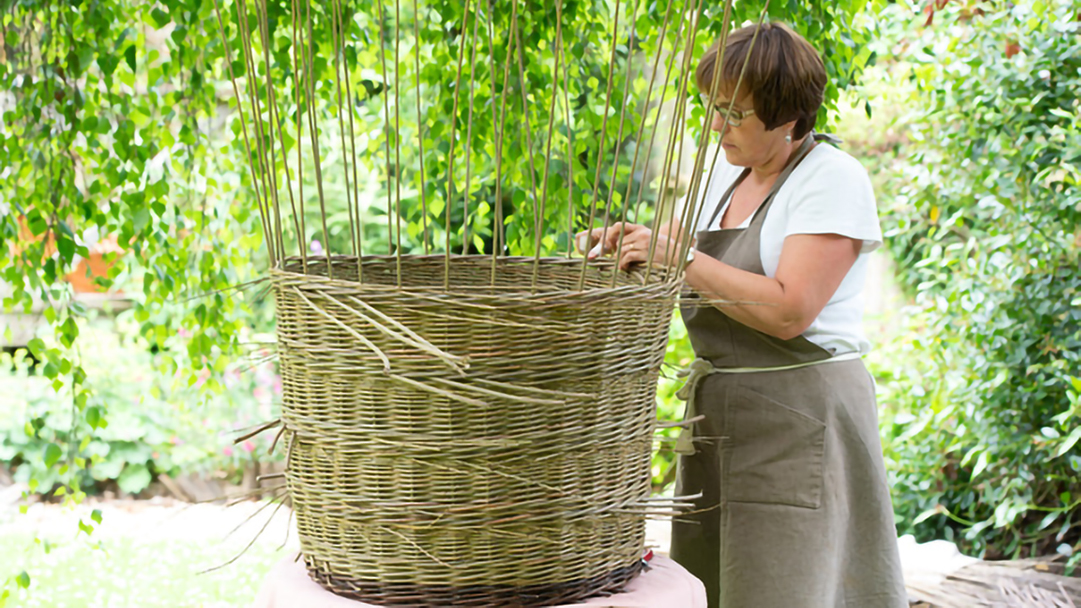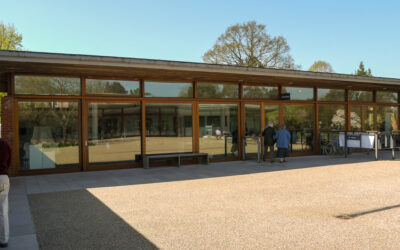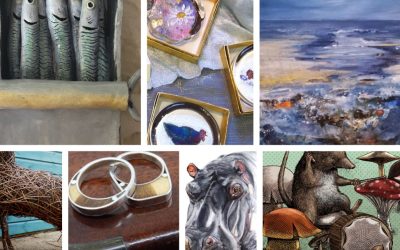In this regular feature we speak to one of the members of the Wessex Guild to find out a bit more about them and their craft, techniques and inspirations.
How did you start doing your craft? What inspired you?
I started basketmaking on a whim, seeing an adult education class advertised. Baskets had always interested me and, being a ‘crafty’ person, I thought it would be great to learn how to make one. I loved it from the word go and was devastated when the course ended after just two terms. I struggled to find any other courses, and resorted to ad hoc workshops. However, I really missed the regular, ongoing teaching that a weekly class offers.
That was 20 years ago and, since then, the interest in basketmaking, along with so many hand crafts, has rocketed. Now there are so many more courses and workshops for beginners to attend.
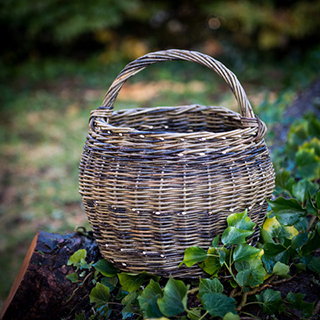
What relevant experience or qualifications do you have?
After many years of occasional workshops, often repeating the same basic skills, I decided to embark on a series of courses run by the City Lit College in Covent Garden. This amazing college runs all sorts of courses and short workshops in basketmaking, especially using ‘alternative’ materials in contemporary designs. However, my love was for traditional willow basketmaking and, when I discovered one of my inspirational makers, Joe Hogan, an Irish basketmaker, was coming over to teach at West Dean College, in Chichester, I was first on the enrolment list!
There followed a number of further workshops there, with other wonderful teachers, and, while attending one, I heard about a City & Guilds course that was about to commence at Westhope College in Shropshire; the only place in the county to run such a qualification.
Distance was no deterrent; I enrolled immediately. While most of the content of the course was already known to me, it was a great boost to my confidence just to realise how much I already knew. But, of course, there were new elements too, and the course ‘joined the dots’ in my skills. It gave me the confidence to think about teaching, which was something I had long wanted to do.
After gaining a basic teaching qualification from Peter Symonds College in Winchester, I started running workshops for them, alongside my own independent basketmaking workshops.
What do you do and where do you do it? Do you have an interesting workspace or location?
Most of my work now is around teaching, as I so love to share this wonderful craft with like-minded folk. But I continue to make and sell baskets at a handful of garden and Christmas fairs, and also attend occasional courses myself, as there’s always so much more to learn!
Since moving to the village of Ropley, near Alresford, I have lost the purpose-built workshop that I used to have and have been ‘making do’ in a rather draughty and rickety, but large, shed in the garden. This hasn’t been ideal, so my productivity has dropped significantly this year, but I’m hopeful of having somewhere new to work very soon.
What I do have, however, is access to a lovely little hall right next to my house where I now run my workshops – or did until Covid-19 came along!
What is your design and making process? Can you explain a little about your techniques?
Basketmaking is somewhat seasonal, as the main resources, willow rods, are harvested during the winter and available as ‘green’ (fresh) willow straight away, or as ‘brown’ (dried) willow some weeks or months later. Purchasing your annual stock too late in the year risks it being sold out, so you have to commit early and purchase exactly how much you will need for the year! I buy from one of the remaining commercial growers on the Somerset Levels, where willow has been grown for basketmaking for hundreds of years.
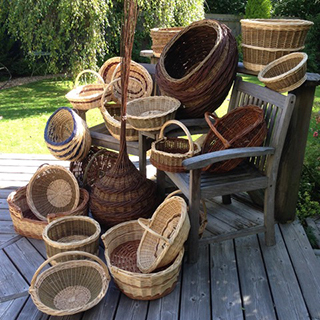
It is possible to weave with green willow, but it’s more common to use dried willow, which the maker rehydrates (soaks in water) to make it pliable again, as required. Using green willow is a delight as it is ‘ready to go’ – soft and bendy, and usable for quite a number of weeks before it dries out. Therefore it is wonderful for spontaneous creations! Sadly, as the completed baskets then dry naturally, the willow shrinks and they become rather loose, which is not welcome.
This problem does not happen nearly so much with soaked brown willow, so this is the way to go. You have to accept the fact that you have to plan far ahead, as the soaking process can take anything from hours, for stripped willow, to several weeks for thick willow that still has its bark on, especially in winter, when the soaking water is cold!
It’s not the sort of craft you can pick up and put down as and when you feel in the mood and I think this is why people enjoy coming to a class as everything has been prepared for you and is ready to use!
My creations are heavily influenced by the materials I have available to me at the time. If I have a good stock of sturdy, long rods, a log basket is the obvious choice. But if I have some lovely, fine, delicate, coloured willows I will create a much more dainty piece, like a small shoulder bag with an intricate weave, possibly with a leather strap to pick out the colour of the willow.
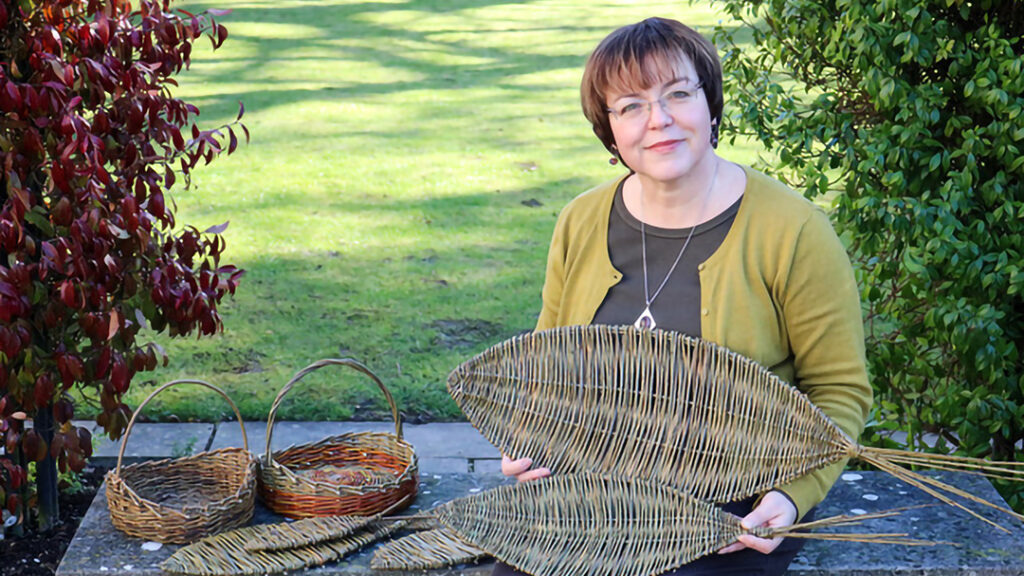
The length and thickness of the rods you have available absolutely dictate what you can make, so I am taken in a certain direction, despite having a desire to create something else! And, as mentioned already, because the willow has to be pre-soaked, you can’t simply change your mind and decide to incorporate some other willow half way through; you just have to work with what you have prepared.
The other aspect to consider is that, once the willow is soaked, there is a finite ‘window’ in which to use that material before it dries out again, so it is no good deciding to go shopping or have a day in the garden when your willow is waiting for you!
Plus, once weaving starts, you need to complete the basket before the uprights that form the shape of the basket dry out, as they are vital to creating the border of the basket and need to stay pliable enough for that.
What is unique about your work? Do you use special methods or make unusual products?
Many of my baskets are very traditional, but I’m enjoying experimenting with more contemporary pieces, mixing styles and weaves, and introducing other materials, such as leather and rush. However, I wouldn’t say anything that I do is unique; all the techniques are already known to basketmakers. It is perhaps the way weaves and shapes are combined that makes designs specific to one maker or another.
Can you tell us the story behind a special artwork you made? Who was it for and why is it memorable?
Most of my work is functional, rather than ‘artwork’, but one interesting commission was where I was asked to make a handbell out of willow for a wedding ceremony.
